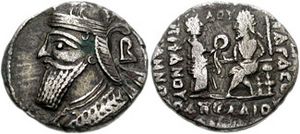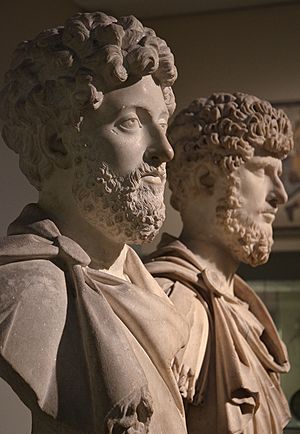Roman–Parthian War of 161–166 facts for kids
The Roman–Parthian War of 161–166 was a major conflict between the Roman Empire and the Parthian Empire. It was fought over control of lands like Armenia and Upper Mesopotamia. The war ended in 166 AD with a Roman victory after they successfully invaded Lower Mesopotamia and Media, even sacking the Parthian capital, Ctesiphon.
Quick facts for kids Roman–Parthian war of 161–166 |
|||||||||
|---|---|---|---|---|---|---|---|---|---|
| Part of the Roman–Parthian Wars | |||||||||
|
|||||||||
| Belligerents | |||||||||
| Roman Empire | Parthian Empire | ||||||||
| Commanders and leaders | |||||||||
| Lucius Verus Avidius Cassius Marcus Claudius Fronto Marcus Statius Priscus Publius Martius Verus |
Vologases IV of Parthia Chosrhoes |
||||||||
Contents
War Begins: Parthian Invasion of Armenia (161–162 AD)
The Roman Emperor Antoninus Pius died in 161 AD. Soon after, Vologases IV of Parthia, a king from the Parthian Empire, decided to act. In late 161, Vologases invaded the Kingdom of Armenia. Armenia was a Roman client state, meaning it was allied with Rome. Vologases removed the Roman-backed king and put his own relative, Pacorus, on the throne.
At this time, Marcus Sedatius Severianus was the Roman governor of Cappadocia. This region was a key border area for conflicts with Armenia. Severianus was convinced he could easily defeat the Parthians. He led a Roman legion into Armenia. However, the Parthian general Chosrhoes trapped his forces at Elegeia. Severianus realized his situation was hopeless and took his own life. His legion was completely defeated. This quick defeat lasted only three days.
More bad news arrived for Rome. The Roman army in Syria, led by Governor Lucius Attidius Cornelianus, was also defeated by the Parthians. This left the Roman Empire in a difficult position.
Marcus Aurelius had become emperor on March 7, 161 AD. He had little military experience. He quickly appointed new leaders. Marcus Statius Priscus, the governor of Britain, was sent to replace Severianus in Cappadocia. Rome also sent many reinforcements to the Parthian border. Three full legions were sent from different parts of the empire. These included Legio I Minervia, Legio II Adiutrix, and Legio V Macedonica. This weakened Rome's northern borders, and governors there were told to avoid any new conflicts.
Lucius Verus Heads East (162–163 AD)
By the winter of 161–162, with more bad news arriving, the Roman leaders made a big decision. They decided that Lucius Verus, Marcus Aurelius's co-emperor, should go to the East to lead the war in person. The argument was that Lucius was stronger and healthier, making him more suitable for military command. The Senate agreed, and Lucius left Rome. Marcus Aurelius stayed in Rome, as the city needed an emperor's presence.
Lucius was accompanied by important officials, including Titus Furius Victorinus, a praetorian prefect, and two experienced senators, Marcus Pontius Laelianus Larcius Sabinus and Marcus Iallius Bassus. Laelianus had been governor of Syria before, so he knew a lot about the eastern army. These men were chosen to help Lucius manage the war.
Lucius began his journey in the summer of 162. He traveled through various Roman cities, sometimes like a royal procession with musicians. He stopped in places like Corinth and Athens. He eventually arrived in Antioch, a major city in the East. Meanwhile, Statius Priscus, the new governor of Cappadocia, had already arrived and began to achieve success in 163.
Roman Operations in Antioch (162–165 AD)
Lucius Verus spent most of the war in Antioch, which served as the main Roman base. He also stayed in nearby resorts like Laodicea and Daphne.
Lucius faced a big challenge. The Roman army in Syria had become less disciplined during a long period of peace. Lucius and his generals worked to improve their training. For example, Pontius Laelianus ordered that the soldiers' saddles be stripped of their padding to make them tougher. Lucius himself often walked at the head of his army and personally checked on soldiers.
To help with supplies, Lucius ordered a new canal to be dug on the Orontes. This allowed ships to reach Antioch more easily. During this project, workers found very large bones, which some believed belonged to a giant.
In the middle of the war, around 163 or 164 AD, Lucius traveled to Ephesus to marry Lucilla, Marcus Aurelius's daughter. Lucilla was about 13 years old at the time. Marcus Aurelius sent her with her mother, Faustina, to the East. This marriage was important for strengthening the bond between the two emperors. Lucilla would later have three children with Lucius.
Roman Counterattack and Victory (163–166 AD)
The Roman legions, including I Minervia and V Macedonica, fought under Marcus Statius Priscus in Armenia. They were very successful in 163. They captured the Armenian capital, Artaxata. At the end of that year, Lucius Verus was given the title Armeniacus, meaning "Victor in Armenia," even though he hadn't personally fought in the battles. Marcus Aurelius also accepted this title later.

Armenia was reorganized under Roman control. A new capital, Kaine Polis (meaning "New City"), was built. A new king, C. Iulius Sohaemus, who was a Roman senator of Armenian descent, was put on the throne. This showed Rome's power in the region.
In 163, while the Romans were busy in Armenia, the Parthians also tried to take control of Osroene. This was another Roman client state in Mesopotamia. The Parthians removed the local ruler and put their own person in charge. In response, Roman forces moved to cross the Euphrates river further south. By the end of 163, Roman forces had secured areas on the northern bank of the Euphrates.
In 165, Roman forces, possibly led by Publius Martius Verus, advanced into Mesopotamia. They recaptured Edessa and put its original ruler, Mannus, back in power. The Parthians retreated to Nisibis, but the Romans besieged and captured this city too.
Another Roman force, led by Avidius Cassius and the Legio III Gallica, moved down the Euphrates river. They fought a major battle at Dura-Europos. By the end of 165, Cassius's army reached the two main cities of Mesopotamia: Seleucia and Ctesiphon. Ctesiphon, the Parthian capital, was captured and its royal palace was burned. The citizens of Seleucia opened their gates to the Romans, but the city was still sacked. This event damaged Lucius's reputation. During the sacking, Roman troops took a statue of Apollo from a temple and brought it back to Rome.
Cassius's army faced challenges, including a shortage of supplies and a terrible plague that had started in Seleucia. However, they managed to return safely to Roman territory. For this great victory, Lucius Verus was given the title Parthicus Maximus (Greatest Victor over the Parthians). Marcus Aurelius also received this title. In 166, Cassius's army crossed the Tigris river into Media. Lucius then took the title Medicus (Victor in Media).
End of the War (Mid-160s–167 AD)
Much of the success in the war was due to the skill of the Roman generals under Lucius Verus. Key figures included Marcus Claudius Fronto, who led I Minervia in Armenia, and Publius Martius Verus, who led V Macedonica. The most important general was Avidius Cassius, commander of III Gallica. These generals were rewarded with important positions and consulships.
After the campaign, Lucius Verus was honored with a triumph in Rome. This was a grand parade to celebrate the victory. It was unusual because both emperors, Lucius and Marcus Aurelius, participated along with their sons and unmarried daughters. Marcus Aurelius's two young sons, Commodus and Marcus Annius Verus Caesar, were given the special status of Caesar during this celebration.
The city of Nisibis, located on the upper Euphrates, remained under Roman control for many decades after the war. It became an important Roman garrison town.
Images for kids




